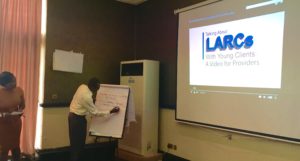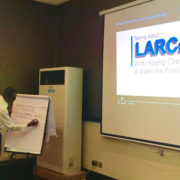Health Providers are Championing LARCs for Youth
“Many health providers carry strong misconceptions about LARCs and youth, turning them into obstacles to young people accessing contraception, rather than being champions and advocates. Just today I visited a clinic where a provider told me that she would not provide an adolescent girl with contraception, nor would she provide contraception to a married woman without her husband’s consent. It is so important that we educate all health providers about LARCs for youth, to promote positive attitudes, and increase the spectrum of services available to young people.” – Dr. Samuel Mukasa, Health Services Coordinator, PACE Uganda

Dr. Samuel Mukasa is a Health Services Coordinator with PACE Uganda.” Photo Credit: Dr. Samuel Mukasa. All rights reserved.
Dr. Samuel Mukasa is a Health Services Coordinator for PACE, PSI’s local affiliate in Uganda. PACE operates the ProFam network – 210 social franchise clinics across five regions, from one-room outpatient posts to medium and large facilities. In a country where nearly half of all 19 year olds have had a child – forty percent of whom wanted to delay their pregnancy – the need for increased access to contraception is vast. We know that some of the biggest barriers to youth accessing contraception, particularly long-acting reversible contraceptive methods (LARCs), are health providers themselves. Despite the evidence that LARCs are highly safe and effective for young people (including those that are unmarried and/or nulliparous), many health providers still aren’t convinced. Years of medical education taught that only certain contraceptive methods, if any at all, were appropriate for young people, combined with sociocultural bias, lead many health providers to hesitate – or even outright resist – discussing LARCs with youth.
Earlier this month, PSI gathered 15 members of PACE’s quality assurance team, including Dr. Samuel, for a five-day training of trainers on delivering youth-friendly health services. The training focused on how PACE can help catalyze health providers to become champions for youth sexual reproductive health (SRH), which is part of a Pfizer Foundation-funded project to transform the way SRH services are provided for youth in Uganda’s private health sector.
As part of PACE’s training we asked two participants to lead a discussion on LARCs for youth, based on the Health Communication Capacity Collaborative (HC3) produced three-minute animated video, “Talking About LARCs with Young Clients: A Video for Providers.” The video, which is narrated by a role-model provider named Maria, addresses the oft-conflicting personal and professional values that providers feel about contraception and young people, and presents four tips for how providers can improve their SRH counseling to include LARCs for youth.

PACE staff facilitating the LARCs and Youth discussion at youth-friendly health services training”. Photo credit Rena Greifinger. All rights reserved.
The facilitators played the video twice through, at the request of the participants, who felt they needed to watch it at least twice to really grasp all of the content and messages. The facilitators then led a participatory discussion, using the corresponding HC3 video discussion guide as a resource, and added some flare to make the activity their own. They posted pieces of flip chart paper in each of the four corners of the room. Each piece of paper had one of the four tips for counseling young people about LARCs (be client-centered, start with LARCs, provide same-day services, and promote dual methods). The facilitators treated the discussion as a “gallery walk,” walking the group from corner to corner and guiding a comprehensive discussion about each tip. While much of the discussion’s content still aligned with the video discussion guide, getting people up and moving really brought energy to the group, and helped participants focus on all of the complexities and discussion points that arose with each tip.
Watching the HC3 resources put to use in a broader training about youth-friendly services taught us a lot about the power of well-produced tools with a facilitated and dynamic discussion. By playing a video that features a health provider speaking directly to her peers, urging them to reflect on their own youth, and then providing four simple and easy-to-remember tips, participants were able to connect with the content immediately and feel empowered to make changes in their own lives and practices.
The facilitators and participants alike really enjoyed this exercise. The facilitators felt the video discussion guide was well laid out, instructive enough, but also allowed them the opportunity to be creative. Participants really loved the exercise, explaining that it helped them focus on clear messaging that they can use in their trainings and supportive supervision visits. It also helped them feel more confident in their own understanding of the safety, effectiveness and appropriateness of LARCs for youth. When they learned that there are accompanying posters and brochures, they were ecstatic. Soon, all of the ProFam clinics taking part in this project will be sporting the new materials.
Additional Resources
Learn more about HC3’s work on LARCS and youth.
Want to use the materials in your program? Find out how.
Watch a webinar recording about the materials.
Make your voice heard! Participate in a Springboard conversation on LARCs and youth.
Watch the video shown at the PACE training:








Leave a Reply
Want to join the discussion?Feel free to contribute!